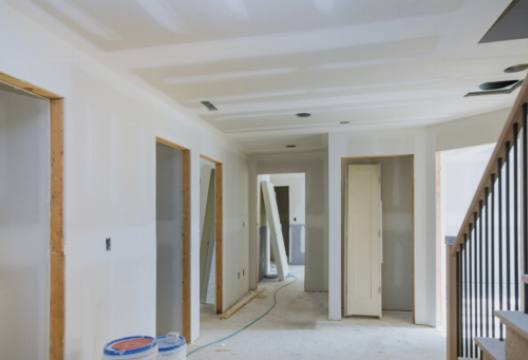Are you tired of hearing every little noise from your neighbors or family members through your walls? Soundproofing your home with drywall can make a significant difference in creating a quieter and more peaceful living space. Understanding the basics of soundproofing, utilizing the right materials, and implementing effective techniques can help you achieve the desired level of sound reduction. By addressing common sound leakage areas and incorporating additional tips for enhanced performance, you can enjoy a more serene environment in your home.

Understanding Soundproofing Basics
It is important for creating a more peaceful and quiet environment in your home. Soundproofing can help to minimize noise from outside sources, as well as reduce the transmission of sound within the home.
There are two main types of soundproofing techniques: blocking sound and absorbing sound. Blocking sound involves using materials that are dense and heavy to stop sound waves from passing through walls, floors, or ceilings. Absorbing sound involves using materials that can dampen sound vibrations, preventing them from bouncing around and amplifying noise.
When soundproofing a room, it is important to consider the different ways that sound can travel. Sound can transmit through walls, ceilings, floors, doors, and windows. By addressing these transmission points, you can effectively reduce the amount of noise that enters or leaves a room.
In addition, it is important to understand the concept of sound transmission class (STC) ratings. STC ratings measure how well a material can block the transmission of sound. The higher the STC rating, the better the material is at soundproofing. By choosing materials with higher STC ratings, you can effectively reduce the amount of noise that enters or leaves a room.
Types of Soundproofing Materials
When it comes to soundproofing a room, there are several types of materials that can be used. These materials play a key role in reducing the transmission of sound from one space to another. Some common types of soundproofing materials include acoustic foam, soundproof curtains, soundproof drywall, mass loaded vinyl, and fiberglass insulation. Each of these materials has its own unique properties and benefits when it comes to soundproofing a space. By understanding the different types of soundproofing materials available, homeowners can choose the best option for their specific needs and budget.
Effective Drywall Soundproofing Techniques
Soundproof drywall is designed to block and absorb sound waves, creating a quieter and more peaceful environment in your home.
One popular type of soundproof drywall is called double-layered drywall. This involves installing two layers of drywall with a layer of soundproofing material in between, such as Green Glue or Mass Loaded Vinyl. This extra layer helps to minimize sound transmission through walls, ceilings, and floors.
Another effective technique is adding soundproofing insulation within the walls. Insulation materials like fiberglass or mineral wool can help absorb and dissipate sound waves, reducing noise transfer between rooms.
Additionally, sealing gaps and cracks in the walls can further improve soundproofing performance. Using acoustic caulk to fill in any holes or openings can help prevent sound leakage and create a more airtight barrier against noise.
For even more enhanced soundproofing, consider adding resilient channels or soundproofing membranes to the walls before installing drywall. These materials can help decouple the drywall from the structure, further reducing the transmission of sound vibrations.
Overall, implementing these effective drywall soundproofing techniques can make a significant difference in reducing noise levels in your home and creating a more peaceful living environment.
Addressing Common Sound Leakage Areas
When it comes to soundproofing a room, addressing common sound leakage areas is crucial in ensuring maximum effectiveness. One common sound leakage area is around electrical outlets and switches. To address this issue, it is important to seal any gaps around outlets and switches with acoustical sealant or soundproofing putty.
Another common sound leakage area is through doors and windows. Installing weather stripping around the edges of doors and windows can help create a tighter seal, reducing the amount of sound that can pass through.
Ceiling and floor gaps can also be a source of sound leakage. Using acoustical sealant or soundproofing mats to fill in these gaps can help to minimize sound transmission between floors.
Additionally, any cracks in walls or ceilings should be filled in with acoustical sealant to prevent sound from passing through.
By addressing common sound leakage areas in your home, you can enhance the effectiveness of your drywall soundproofing efforts and create a quieter, more peaceful living environment.
Additional Tips for Enhanced Soundproofing Performance
When it comes to enhancing the soundproofing performance of your home, there are a few additional tips that can make a big difference. One key tip is to seal any gaps or cracks in your walls, floors, or ceilings with acoustic caulk. These small openings can allow sound to easily pass through, so sealing them effectively can help improve the overall soundproofing of your space.
Another tip is to consider adding soundproofing curtains or drapes to your windows. These heavy-duty curtains can help block out external noise and create a more peaceful environment inside your home. Additionally, adding thick area rugs or carpeting to your floors can help absorb sound and reduce echoing in the room.
If you're looking to take your soundproofing efforts to the next level, consider installing soundproofing panels on your walls. These panels are designed to absorb and deflect sound waves, significantly reducing noise transmission between rooms. You can also add a layer of mass-loaded vinyl under your drywall for even greater soundproofing performance.
Finally, don't forget to address any gaps or leaks around doors and windows, as these can be prime areas for sound to travel through. Adding weatherstripping or door sweeps can help seal these areas and prevent sound from entering or escaping your home.
By incorporating these additional tips into your soundproofing efforts, you can create a quieter and more peaceful living environment for you and your family.
